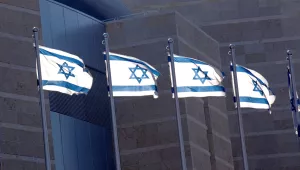Introduction
The Middle East stands at a critical crossroads, and the current geopolitical landscape presents a unique opportunity for bold diplomacy by President Trump and his administration.
The October 7th attacks and the ensuing Gaza war have reshaped the region’s political dynamics, similar to the 1973 Yom Kippur War, which led to eventual peace between Israel and Egypt. Returning to the status quo ante is untenable. It is a formula for continuing conflict, regional instability, and promoting more extremism and terrorism. United States national interests are at risk.
However, there is a way forward: A grand bargain that is outcome oriented and that in the near term ends the war in Gaza which would then lead, in the longer term, to addressing comprehensively the Israeli-Palestinian conflict and the broader challenge posed by Iran. This initiative could foster lasting peace and regional security, but it will require strong leadership and strategic vision by all the parties involved.
The Grand Bargain: A Bold Path Forward
Within a timeframe of the next few years and moving from failed conflict management to conflict resolution, this initiative would address two key sources of regional turmoil: the Israeli-Palestinian conflict and Iran’s disruptive influence. This approach seeks a comprehensive resolution by offering tangible incentives to key players, encouraging them to choose peace over perpetual conflict. The first step toward this grand bargain would necessitate obtaining a sustainable ceasefire in Gaza, return of the Israeli hostages and Palestinian prisoners, establishing effective governance in Gaza, and start rebuilding the Gaza Strip.
A longer-term strategy incorporating a political horizon for Israelis and Palestinians could dissipate the deeply rooted hostilities and despair in both societies and pave the road toward addressing the conflict through negotiations resulting in the mutual recognition of each side’s right to self-determination.
The core tradeoff of a grand bargain would be:
- For Israel and the Palestinians, a newly elected Israeli government that would cease annexationist policies and agree to negotiations with a newly elected Palestinian leadership to start advancing toward a peace settlement, preferably a Two State Solution which is the ultimate guarantor of Israel’s democratic and Jewish identity. The United States would enhance its strong relationship with Israel to assure that any peace agreement will be backed with ironclad United States security guarantees. Additionally, the United States would engage directly with Arab and Muslim countries, especially Saudi Arabia, to have them normalize their relations with Israel in the context of an Israel-Palestinian peace agreement and the Abraham Accords.
- For Iran, the approach would be both credible pressure and credible engagement. The outcome of this approach would involve: First, that Iran agrees not to obtain nuclear weapons and related ballistic missile capabilities. In this respect the focus should be not so much on fissile material, but on an unlimited timeframe prohibiting nuclear weaponization with strong safeguards and inspections. Iran would still be able to pursue its civilian nuclear program under NPT safeguards. Second, that Iran support whatever the Palestinians agree to in peace negotiations with the Israelis; Third, that Iran cease and desist its support of terrorist groups and proxies in the so-called “Axis of Resistance.” Fourth, that Iran pursues friendly relations with its neighbors. In exchange, the United States will end sanctions, pledge that it is not pursuing regime change, which is a matter for the Iranian people to decide, and engage in a dialogue with the prospect of improving bilateral relations leading to the renewal of diplomatic relations.
The Israeli-Palestinian Component
Israel’s long-term security depends on resolving the Palestinian conflict. The current government in Israel has not demonstrated the political will to engage on a negotiated settlement. The continued occupation and expansion of settlements have only deepened hostilities. As senior Israeli commentator Ehud Yaari has stated if these policies continue: “Israel will be required to deal with shaky, half-baked, and vague agreements, which will require constant supervision and systematic, intermittent operation of IDF forces.”
A Two-State Solution is a preferable outcome than the alternatives. Without it, Israel faces a demographic and democratic crisis. There are approximately over 7 million Israeli Jews and over 7 million Palestinian Arabs between the Jordan River and the Eastern Mediterranean Sea. Other than the internationally illegal option of forced displacement, neither one nor the other is going anywhere else. Under a One State Solution Israel will lose either its Jewish identity because of the stronger demographic growth factors on the Palestinian side, or its democratic nature because of unequal rights between Arabs and Jews. Israel will have to decide whether it is to be the democratic State of Israel or the apartheid State of Judea and Samaria. By agreeing to a framework based on land-for-peace, Israel could secure its Jewish and democratic identity while normalizing relations with the wider Arab world. Elections bringing in an Israeli government that is committed to peace negotiations would be necessary for this option to move forward.
For the Palestinians, this bargain offers a path toward sovereignty, economic prosperity, and international legitimacy. While the current Palestinian Authority is the legal representative of the Palestinian people, its ineffective leadership and its failure to deliver peace and security to its people and initiate state building have eroded its legitimacy. The path would have to be prepared for a newly elected Palestinian leadership that would be committed to negotiations and structural internal reforms, and that is not governed by Hamas which would have to be demilitarized. The recent demonstrations in Gaza against Hamas may be an indication that a new Palestinian government that excludes Hamas from any leadership role may be more feasible. Concomitantly, the United States would work with regional allies to ensure Palestinian governance is effective and representative, creating the foundation for a viable and independent state.
The United States should put forward its vision and concept for Israeli-Palestinian peace in a comprehensive statement of policy that goes beyond rhetoric for a Two State Solution and that contains an outline for the path forward. Such frameworks have been presented in the past, including President Trump’s “Peace to Prosperity” proposal in January 2020 for the establishment of a Palestinian state. The United States could enhance the success of peacemaking with Terms of Reference for an acceptable end of conflict for both parties. The point here is to provide a political horizon that the parties could adhere to and would provide some hope for realizing the end of the Israeli-Palestinian conflict with future implications for the unfinished business of peace on the Lebanese and Syrian fronts.
The Iranian Component
Despite the diminution of its Axis of Resistance by recent Israeli operations, Iran’s regional ambitions and nuclear aspirations remain a major destabilizing force. However, Tehran also faces serious domestic political and economic problems and international isolation, creating an opportunity for diplomacy. This grand bargain offers Iran a way to secure its interests while abandoning its most provocative policies. By agreeing to verifiable prohibitions and restrictions on its nuclear program, endorsing any peace agreement the Palestinians reach with Israel, ceasing support for militant proxies, Iran could gain sanctions relief and normalized relations with the United States and its allies. This dual approach—credible pressure coupled with credible engagement—would shift the regional balance away from perpetual confrontation toward a sustainable peace.
A New Regional Security Architecture
A broader regional security framework should be established to support lasting stability. This would involve:
- Strengthening regional security arrangements along Israel’s borders with Gaza, Lebanon and Syria to prevent future escalations and a wider conflict that could drag the United States into a war, for example with Iran that would not serve United States national security interests.
- Implementing UNSCR 1701 to stabilize the Lebanese-Israeli border and address Hezbollah’s military presence in Lebanon.
- Ensuring that Syria’s political transition after the fall of the Assad regime is inclusive representing the diversity of all Syrian society and that Syria does not become a battleground for regional rivalries.
- Engaging key Arab states in the Gulf, especially Saudi Arabia, to bolster the political. economic and security arrangements needed to stabilize the countries in the region.
The Role of American Leadership
A grand bargain and a new regional security architecture cannot materialize without strong U.S. leadership. President Trump has the chance to shape history by championing this vision over the next four years of his mandate. America’s credibility and influence in the region would be enhanced. This initiative would strengthen alliances, curb extremism, enhance energy security, stabilize global markets and put the focus on economic development rather than perpetual conflict—all of which align with U.S. national interests. In the words of an Arab Gulf leader, both Israel and Iran are living by the sword while the rest of the region is striving to develop their societies to meet the geo-economic challenges of the future.
The choice is clear: Continue down the recent and current path of stop gap arrangements resulting in endless conflict or seize this historic moment to build a lasting peace. With courage and strategic vision, President Trump and his Administration can mediate a grand bargain that reshapes the Middle East and strengthens the national security interests of the United States.




